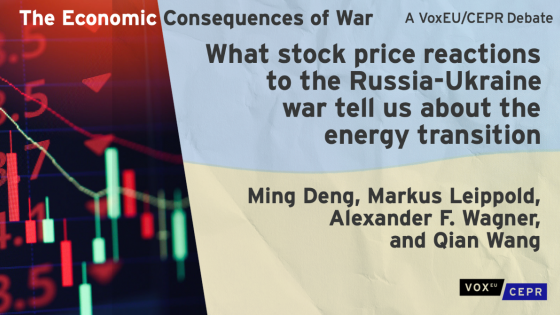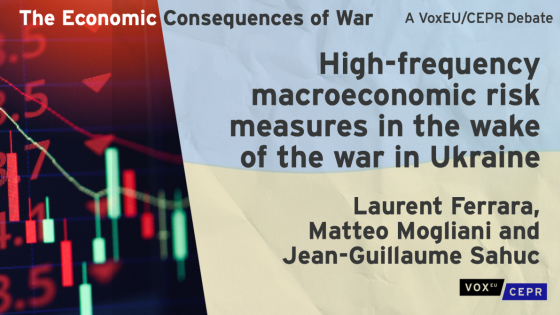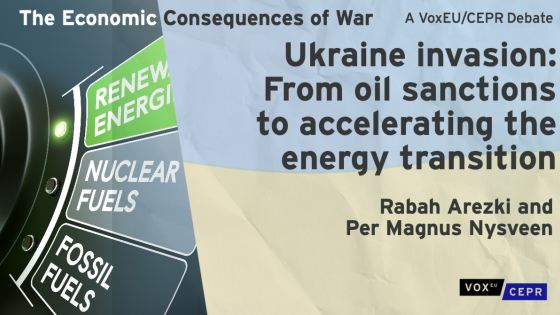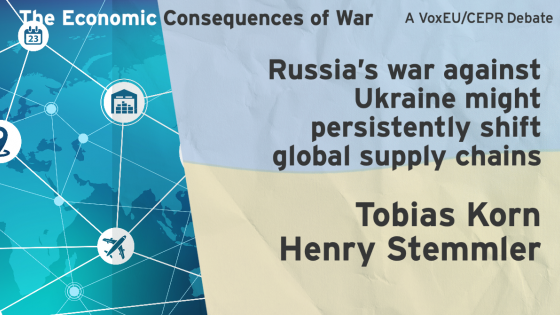Editors' note: This column is part of the Vox debate on the economic consequences of war.
Even before the war broke out in Ukraine, investors worldwide were facing a unique, challenging mix of events: restart of economic activity after COVID-19, fear of new virus strains, surging inflation, and new monetary policy and central bank frameworks, among others. The tragedy of war in Europe and the prospect of far-reaching geopolitical repercussions has added another black swan to the flock.
Besides the direct human toll of the war, a much-discussed question – not least in the light of climate change concerns and the recent report of the Intergovernmental Panel on Climate Change (2022) – is whether the geopolitical crisis due to the Russian invasion of Ukraine is likely to accelerate or retard the transition to a low-carbon economy. Chepeliev et al. (2022) argue that restricting Russia’s fossil fuel exports would have considerable environmental co-benefits (and moderate adverse effects on EU household incomes but large negative effects on the Russian economy). Arezki and Nysveen (2022) emphasise the importance of demand-based policies, such as incentives for individuals to use electric vehicles.
Unfortunately, the spread of the conflict, future sanctions, the responses of companies and other countries, and individual behaviour are unknown, complicating attempts to quantify the expected economic impact of the war. However, we can gain valuable information about current expectations from changes in asset prices; the researcher does not need to trace all the future changes to cash flows and discount rates separately (Schwert 1981). Ferrara et al. (2022) utilise high-frequency aggregate financial market data and infer that downside risks for the macroeconomy perceived by financial markets in the euro area are about three times higher than those for the US economy. The cross-section of stock price reactions offers a particularly informative preview of the future economic impact of the Russia-Ukraine war, including regarding the impact on the energy transition.
Leveraging this insight, in a recent paper (Deng et al. 2022), we investigate the stock price reactions of firms around the globe to the Russia-Ukraine war in early 2022 and its consequences. While the invasion on 24 February 2022 had been visibly prepared in the prior months, many observers still were surprised that President Putin went ahead with this step.
We draw on a cross-section of roughly 3,500 global stocks for which we have a wide variety of firm characteristics. The key variables of interest in this column are our proxies for corporate climate risk exposure. We differentiate between exposure to transition (regulatory) risk and physical climate risk. The general idea is that when companies with higher transition risk do better on stock markets, investors expect the transition to the low-carbon economy to slow down.
Firm-level proxies for transition risk
We employ two proxies for transition risk and physical risk based on methods from natural language processing. Sautner et al. (2020) utilise quarterly earnings conference calls from a global sample to construct a set of different firm-specific climate risk measures. We use their transition (regulatory) risk and physical risk scores for our study. As an alternative, we also use Kölbele et al.’s (2020) approach. They utilise information from Item 1.A of 10-Ks and a contextual natural language processing approach to extract transition and physical risk. Since this measure is based on the analysis of Item 1.A of 10-Ks, it is only available for US firms.
We consider three phases: Build-up (from the time NATO put its troops on stand-by on 24 January 24 to 23 February); Outbreak (from 24 February, the day of the invasion, to 8 March, the day after the US announced a ban on Russian oil, gas, and coal); and Continuation (from 9 March to 31 March).
Our key finding is summarised in Figure 1, which we construct as follows. We run regressions of the cumulative return starting from January 24 through each trading day on the horizontal axis on transition and physical risk. The figure then plots the evolution of coefficients together with the 90% confidence intervals. The control variables include firm characteristics (such as firm size, cash holdings, exposure to market risks, etc.) and country and industry fixed effects. The red (top) line shows results for US companies and the blue line for European companies.
Figure 1 Development of stock prices of companies with high climate transition risk
In all three phases, but especially in Outbreak and Continuation, US firms with high climate transition risk did well. While the figure displays the result for Sautner et al.’s (2020) data, the same inference is obtained with Koelbel et al.’s (2020) measures. These results suggest that investors generally expect the transition to a low-carbon economy in the US to slow down relative to what was previously expected. Strikingly, in Europe, stocks with high transition risk did not exhibit such outperformance, and in fact somewhat underperformed in the Outbreak period. This observation may be due to stronger expected policy responses supporting renewable energy sources, which, given the continent’s relatively pronounced dependency on Russian oil and gas, is arguably the only way for the Europe to enhance its energy security.
In short, the speed of transition to a low-carbon economy appears to be diverging between the US and Europe.
Other factors
Our analysis controls for a range of potentially important factors that, if uncontrolled for, could confound the inferences. First, some of the results on transition risk may reflect broader corporate environmental responsibility or even wider aspects of social responsibility or corporate governance. Therefore, throughout, we also control for environmental, social, and governance (ESG) measures. It turns out that some of these measures are positively related to performance in some of the three periods (but then reverse), others negatively (and then reverse), and yet others not at all. Hence, investors cannot easily rely on such scores for their investment decisions in the face of a disaster like war.
Second, the shortage of energy supplies from Russia and fear of food shortages (e.g. wheat supplies from Ukraine) present a supply shock that can lead to additional inflation (and corresponding monetary policy responses). Indeed, firms for which a textual measure suggests strong exposure to inflation risks performed worse, especially in the Outbreak period. The fact that the underperformance of these stocks continues into the Continuation period resonates well with a statement made by ECB’s Christine Lagarde. In a news conference on 10 March 2022, she stated that the “Russia-Ukraine war will have a material impact on economic activity and inflation through higher energy and commodity prices, the disruption of international commerce and weaker confidence”.' Thus, our analysis reveals that inflation risk is an ongoing concern for investors.
Third, the data also point to investor concerns regarding the international exposure of companies in general. Companies with a higher share of international sales underperformed. As suggested by Korn and Stemmler (2022), the Russia-Ukraine war may have persistent effects on global supply chains. China-oriented companies strongly underperformed (net of all other effects) during the Outbreak period. This may be due to the recent outbreak of COVID-19 in China (and corresponding supply-chain difficulties), or it may point to wider-ranging geopolitical consequences of the Russia-Ukraine war – in particular to increased tension between the US and China.
Summary
Investors have recently had to navigate a unique amalgam of geopolitical, macroeconomic, and (environmental) policy challenges. Considerations regarding energy security and climate change turn out to play a major role for firm values. Specifically, our study shows that geopolitical disruptions have subtle effects on how climate transition risk is priced into equity markets. The current crisis brings a tension between energy security and the transition to the low-carbon economy powerfully to the fore. Resolving this tension will require major policy efforts.
References
Arezki, R and P M Nysveen (2022), "Ukraine invasion: From oil sanctions to accelerating the energy transition", VoxEU.org, 1 April 1.
Chepeliev, M, T Hertel, and D van der Mensbrugghe (2022), "Cutting Russia’s fossil fuel exports: Short-term pain for long-term gain", VoxEU.org, 9 March 9.
Deng, M, M Leippold, A F Wagner, and Q Wang (2022), "Stock Prices and the Russia-Ukraine War: Sanctions, Energy, and ESG", CEPR Discussion Paper 17207.
Ferrara, L, M Mogliani, and J-G Sahuc (2022), "High-frequency macroeconomic risk measures in the wake of the war in Ukraine", VoxEU.org, 7 April 7.
IPCC (2022), Climate Change 2022: Impacts, Adaptation and Vulnerability, WGII Sixth Assessment Report.
Kölbel, J, M Leippold, J Rillaerts, and Q Wang (2020), "Ask BERT: How regulatory disclosure of transition and physical climate risks affects the CDS term structure", working paper.
Korn, T and H Stemmler (2022), "Russia's war against Ukraine might persistently shift global supply chains", VoxEU.org, 31 March.
Sautner, Z, L van Lent, G Vilkov, and R Zhang (2020), "Firm-level Climate Change Exposure", working paper.
Schwert, G W (1981), "Using financial data to measure effects of regulation", The Journal of Law and Economics 24: 121-158.








